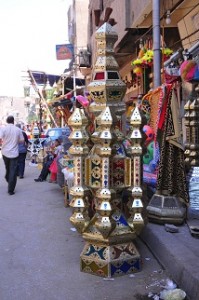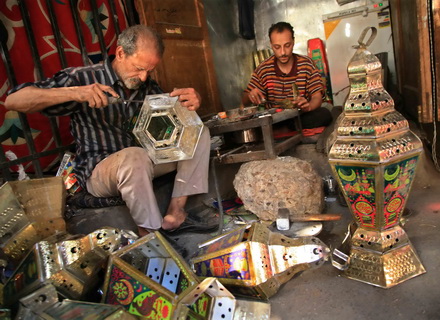 Reminiscent of European and American streets during Christmas, the streets of Cairo – and the rest of Egypt – are transformed during the holy month of Ramadan. Filled with special tent-like decorations and colourful light bulbs they evoke a childlike sense of expectation and joy. Dangling from balconies, lightning up entrances of buildings and strung across streets – the special lanterns, the fawanees, are the heart of the Ramadan decorations.
Reminiscent of European and American streets during Christmas, the streets of Cairo – and the rest of Egypt – are transformed during the holy month of Ramadan. Filled with special tent-like decorations and colourful light bulbs they evoke a childlike sense of expectation and joy. Dangling from balconies, lightning up entrances of buildings and strung across streets – the special lanterns, the fawanees, are the heart of the Ramadan decorations.
In an attempt to find out the secrets of the fawanees, I took a special trip to the Al Hossein area of Cairo, and across the street from the Khayameya tentmakers alley I found a true treasure trove. The wide street was transformed into a scarf with an embroidered border as stalls lined the road filled with authentic lanterns in a riot of colours and gleaming metal in all sizes and shapes. The area promised to be one of the main destinations of any lantern-seeker in Cairo.
“We are already wrapping up the business for this season,” Ahmad Saeed, a lantern-seller, said, proving that Egyptians do their lantern-shopping a good while before the start of Ramadan. “The business was ok this season; last year was better though, and the year before even more,” Saeed confided to The Daily News Egypt. A decline in business not long after the uprising when its aftermath of security instabilities were still fresh seemed logical, but a rise of sales could have been expected this time around. “Last year, there was this happiness which enveloped Egyptians following the success of the revolution,” Saeed explained his take of the matter. “Now that things are not taking the shape people hoped for their mood is not that positive anymore.”
The reduction of foreign tourists visiting Egyptian does not take its toll on the fate of the lanterns. “We mainly rely on Egyptian customers when it comes to selling lanterns,” Saeed said. “The slow arrival of tourists has indirectly affected our business in terms of selling to hotels and restaurants which serve them, but the negative effect is not massive.”
Strolling around the area it was hard to imagine that anyone who visited could resist leaving without buying at least one lantern and I succumbed to the temptation. The fawanees on display catered to all interests, tastes, uses and price catagories. “A big lantern like this one,” Saeed was referring to one almost one-metre tall, “takes half a day to make and costs around EGP 120.” The most expensive one we found went for EGP 400 and was nearly as tall as I am.
Most lanterns on display used electric bulbs as a light source. Overcome with a bit of nostalgia I asked whether the traditional candle-lighted lanterns I used to receive as a gift still exist. “They do,” Saeed confirmed, “You can find them ranging from EGP 5 to EGP 20.”
I was happy to know that the history of candle-lit, proper fawanees is safe, despite the fierce competition of mass-produced plastic lanterns that can sing and dance. Cherishing this last piece of heart-warming news I left the street, no longer worried about the fate of Egypt’s beloved lanterns.




